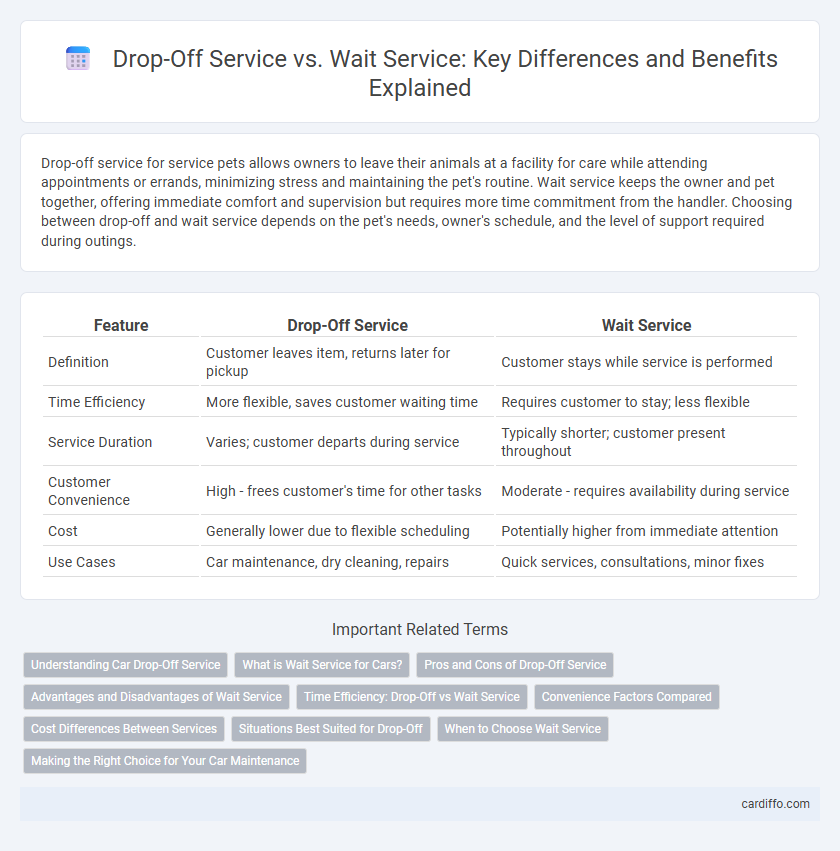Drop-off service for service pets allows owners to leave their animals at a facility for care while attending appointments or errands, minimizing stress and maintaining the pet's routine. Wait service keeps the owner and pet together, offering immediate comfort and supervision but requires more time commitment from the handler. Choosing between drop-off and wait service depends on the pet's needs, owner's schedule, and the level of support required during outings.
Table of Comparison
| Feature | Drop-Off Service | Wait Service |
|---|---|---|
| Definition | Customer leaves item, returns later for pickup | Customer stays while service is performed |
| Time Efficiency | More flexible, saves customer waiting time | Requires customer to stay; less flexible |
| Service Duration | Varies; customer departs during service | Typically shorter; customer present throughout |
| Customer Convenience | High - frees customer's time for other tasks | Moderate - requires availability during service |
| Cost | Generally lower due to flexible scheduling | Potentially higher from immediate attention |
| Use Cases | Car maintenance, dry cleaning, repairs | Quick services, consultations, minor fixes |
Understanding Car Drop-Off Service
Car drop-off service enables customers to leave their vehicles at a designated location while maintenance or repairs are performed, offering convenience and time-saving benefits. Unlike wait service, which requires customers to remain on-site during the service duration, drop-off service allows flexible scheduling and eliminates the need to wait at the repair shop. This service optimizes customer experience by minimizing disruption to daily routines and streamlining vehicle maintenance processes.
What is Wait Service for Cars?
Wait Service for cars involves a technician staying with the vehicle during maintenance or repairs, ensuring immediate attention to any emerging issues and allowing for real-time communication with the customer. This service enhances transparency, reduces downtime, and provides convenience for clients who prefer to have their car serviced without leaving it at the shop. Wait Service is especially beneficial for minor repairs or inspections where quick turnaround is essential.
Pros and Cons of Drop-Off Service
Drop-off service offers the convenience of leaving items for service without waiting, saving customers time and allowing businesses to manage workloads efficiently. However, it lacks immediate feedback or on-the-spot adjustments, which can lead to miscommunications or delays if issues arise. While drop-off service enhances flexibility and operational flow, it may reduce the personal interaction and instant problem resolution found in wait service.
Advantages and Disadvantages of Wait Service
Wait Service enables customers to receive immediate assistance and personalized attention, enhancing satisfaction and allowing for real-time customization. However, it may result in longer total time spent at the service location and can lead to inefficiencies during peak demand periods. Businesses must balance the advantages of tailored customer experience against possible wait times that could deter time-sensitive clients.
Time Efficiency: Drop-Off vs Wait Service
Drop-off service maximizes time efficiency by allowing customers to leave their items and resume activities immediately, minimizing downtime. Wait service requires customers to stay on-site, which can extend total service duration and reduce productivity. Businesses offering drop-off options often experience higher customer satisfaction through faster turnaround and convenience.
Convenience Factors Compared
Drop-off service offers unmatched convenience by allowing customers to leave their items and return later, eliminating wait times and fitting seamlessly into busy schedules. Wait service provides immediate attention and real-time updates, catering to those who prefer instant resolution and personalized interaction. Both services enhance customer experience by balancing flexibility with efficiency, depending on individual time constraints and preferences.
Cost Differences Between Services
Drop-off service typically incurs lower costs as customers leave items for service and return later, minimizing labor and resource usage. Wait service often demands higher pricing due to immediate attention, increased staffing, and enhanced convenience provided to customers. Businesses balance these costs against customer preferences to optimize operational efficiency and profitability.
Situations Best Suited for Drop-Off
Drop-off service is ideal for customers with tight schedules who prioritize convenience over immediate completion, allowing them to leave items for repair, cleaning, or maintenance without waiting on-site. This service suits complex or time-consuming tasks, such as auto repairs, dry cleaning, or tech gadget servicing, where professionals require extended time to ensure quality work. Businesses benefit from drop-off options by managing workflow efficiently while customers avoid long wait times and enjoy flexibility in daily routines.
When to Choose Wait Service
Wait Service is ideal when quick service is essential, such as during tight schedules or urgent repairs, ensuring immediate attention without leaving your vehicle. It suits minor maintenance tasks or diagnostics that can be completed within a short timeframe, allowing customers to avoid multiple trips. Choosing Wait Service enhances convenience by providing real-time updates and immediate feedback from technicians.
Making the Right Choice for Your Car Maintenance
Choosing between drop-off service and wait service for your car maintenance depends on your schedule and convenience preferences. Drop-off service offers flexibility by allowing you to leave your vehicle and return later, while wait service lets you monitor the repair process in real-time, often saving time. Evaluating factors like appointment duration, service complexity, and personal availability ensures the optimal decision for efficient car care.
Drop-Off Service vs Wait Service Infographic

 cardiffo.com
cardiffo.com